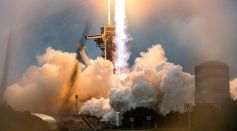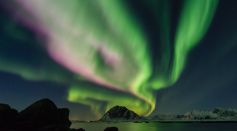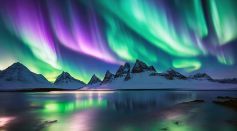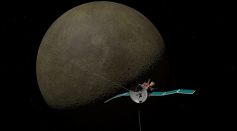Tags: Aurora

Northern Lights From Space: NASA Astronaut Captures Ethereal Green Aurora Over Earth

Martian Auroras Observed: Solar Flares and Coronal Mass Ejections Reach Mars, NASA Reveals
Major Solar Storm Headed for Earth This Week; Powerful Eruption Could Cause 60% Chance of Radio Blackouts and Northern Light Displays

Massive X8.7 Solar Flare From Super-Active Sunspot Causes Radio Blackouts Over North, South America Days After Widespread Aurora Displays
Northern Lights To Be Visible in Much of US Due to Powerful Space Weather Condition; How Can G5 Storm Trigger This Cosmic Spectacle?
NASA’s MAVEN Spacecraft Captures Planet-Wide Aurora Lights Rippling Across the Atmosphere of Mars

Aurora Colors: What Causes Red, Pink, Purple, Green and Yellow Northern Lights?
Decoding Celestial Secrets: When a Phenomenon Named STEVE and the Green 'Picket Fence' Masquerades as Auroras

World’s First Recorded Pregnant Megamouth Shark Found Washed Up Along Philippine Coasts

Analysis of the 1872 Solar Storm Reveals Its Modern Implications for Technology Vulnerabilities

SpaceX Auroras: De-orbiting Rockets Create Bright 'Holes' in Upper Atmosphere, Prompting Unrecognized Concerns Among Scientists

Aurora on the Sun Spotted by Astronomers For the First Time Ever; Is This Similar to Those Seen on Earth?

Sunspot Unleashes Prolonged Aurora-like Emission in Unprecedented Solar Phenomenon

Spectacular Northern Lights Show Anticipated in Northern US, Following Sun's Magnetic Activity Surge

Northern Lights Extravaganza: More Aurora Displays Expected in the Next Four to Five Years

Stay Tuned: Northern Lights May Be Visible From the US on Tuesday Due to Solar Storm

NASA Parker Solar Probe Becomes the First To Fly Through Coronal Mass Ejection From Sun, Allowing the Closest CME Observations Ever Seen
Unraveling Nature's Enigma: The Top 5 Bizarre Weather Phenomena That Defy Explanation

BepiColombo Probe Discovers Universal Auroral Processes, Revealing Astonishing Findings on Mercury's Atmosphere

Northern Lights Forecast: Stunning Aurora Borealis Expected To Illuminate Multiple U.S. States This Week
Most Popular

Largest Known Volcanic Aquifer Discovered Beneath Oregon's Cascades

New 'Supergiant' Sea Bug Found in South China Sea, Named After Darth Vader

Mediterranean Sea Was Refilled by a Catastrophic Flood Millions of Years Ago

Mysterious Cosmic Waves That Sound Like Birds Detected in Unexpected Space Region





